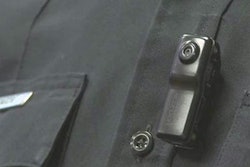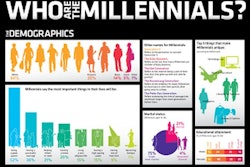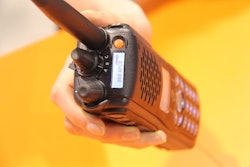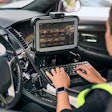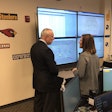Ten years ago in Police Magazine, we were talking about the revolution of the 5-megapixel digital still cameras representing a “quantum leap” in law enforcement. Today, officers are wearing video cameras and departments are struggling with what to do with all that data. Departments are now looking for the best ways to gather, analyze, and store zettabytes worth of multimedia data. We’re also now facing hordes of hackers who are targeting computers, big data, drones, and yes, even our food and DNA. Such were the topics discussed at a special program on the future of law enforcement held at TASER International headquarters in Scottsdale, Ariz., last month.
The program was the brain child of Rick Smith, CEO of TASER, who recently attended the 7-day executive program at Singularity University in Moffett Field, Calif. The program exposed him to emerging technologies that we all will be eventually experiencing in our careers and lives. He brought the program back to TASER headquarters and compacted it into a 10-hour multi-instructor presentation titled “Future Trends in Accelerating Technologies."

When I arrived, I saw the main floor of the TASER building had been turned into a high-tech classroom with seating for about 100, a raised stage, and a jumbo video display that rivals the one at the new Texas Stadium. The seats were rather low tech, which made it difficult to stay comfortable until the speakers started. After the program started, the comfort of my butt took a backseat to the uncomfortable feeling of being on the edge of a real “quantum leap” into unfathomable technology. I spent my day enthralled by what was being presented by some of Silicon Valley’s best futurists.
Singularity University’s Salim Ismail set the tone of the day with some very well plotted statistics about how many people will be connected, digitized, and hackable in the next 10 years. This is because of millions of smart phones with the power to connect us to people across the world and, more terrifying, connect criminals to victims around the globe. My first thought was that cybercrimes units in local police departments are woefully understaffed for what’s coming at them.
Biotechnology was a favorite topic of the day’s speakers. Ismail put the human DNA sequencing into perspective, saying that anyone will be able to get their genetic profile done for about a hundred bucks in the near future. So what does the 2008 mapping of the entire human genome have to do with law enforcement? Well, for one, the technology is now available to code the DNA from a cigarette butt and use the profile to compose a computerized 3D image of the donor’s face. Couple that with the steadily advancing facial-recognition programs, and you could have a suspect identified with very little effort. Gone are the days of combing a file drawer full of photo mug shots.

Throughout the day, I tried to focus the information on how it would effect law enforcement. Here’s a list of some of the topics that were discussed and how I think they will affect policing in the near future.
Drones, Quad Copters, Automated Vehicles.
Amazon.com announced the day before Cyber-Monday that it will soon be using drones to deliver goods to consumers. CBS's "60 Minutes" picked the story up, fulfilling Amazon’s Christmas wishes for a successful marketing ploy. The reality is that using drones to deliver goods to Amazon's customers is not feasible in the near future, but it worked to get people thinking about the future of moving things from point A to point B.
Police agencies are not allowed to use drones unless they jump through political and regulatory hoops. But criminals don't have to follow the rules and are using drones and unmanned vehicles quite effectively. Drugs are being brought into the country by unmanned submersibles and rioters are using aerial surveillance to keep an eye on the riot police. So that got me to thinking, what is our collective law enforcement policy on unmanned vehicles? Have we thought this all out, or are we just waiting for trial-by-fire education? It really may be trial-by-fire when you see some of the advances in autonomous vehicles. There are some dark elements in society that are arming drones, delivering contraband into prisons with drones, or using them to surveil the police from the air. So, what are you going to do the next time you are working an active police situation and you see an unidentified quad copter flying overhead? Are you going to shoot it down? Maybe you will, maybe you won’t, but you better start thinking about it.
Something more terrestrial in nature is the advancement in driverless cars. Hundred’s of thousands of miles have already been logged in the Google cars with no collisions. That’s quite impressive. A handful of states have already decided to make these cars legal on the streets, the rest will be considering it over the next few years. Think about pulling over a car, finding it full of intoxicated passengers and no driver. Who is actually in physical control of the car? There are companies that are ordering these cars by the thousands, so chances are in the next 10 years, you’ll be seeing these in your town.
When you go to the big law enforcement product shows, you see law enforcement drones and quad copters that look like something you’d buy at the local hobby store. But there are more efficient, smaller airborne surveillance vehicles being developed right now. I saw a product that was dubbed a “nano hummingbird” aerial vehicle that can slip through an open window like a bird and beam audio/video surveillance to remotely located officers. If we could only get the flight rules for drones more in line with the reality, law enforcement may be able to actually use some of these devices.
Big Data
As I started off this article, I thought about the late 1990s when I was working on a surveillance squad and we got our first digital camera. You remember the ones that you inserted a 1.44KB floppy disk into? That was the first moment most agencies had to consider what to do with digital evidence. Fast-forward to the dawn of 2014 and you have police agencies trying to figure out what to do with gigabytes, even terabytes worth of multimedia digital evidence. Today we are mulling over the same issues as we did when we put the floppy in the side of the camera. What are we to do with all the digital files? How do we secure them? And how do we ensure that they are not altered before they get to court?
A cyber-investigator I spoke with recently told me that his department has more than 100 terabytes of information in various locations and formats, and it is trying to figure out what to do with all of it. There are choices right now, but the reality is that all of the digital evidence storage solutions of today are in their infancy. From what I heard at the future trends program, terabytes are the new megabytes, and tomorrow, exabytes will be the new terabytes. It’s mind-boggling to consider where all the bytes will be stored and secured. Police agencies better start thinking seriously about storage solutions. Are they going to use an external cloud service like TASER’s Evidence.com or build their own server farms in their evidence rooms?
Robotics/Artificial Intelligence
Singularity University’s Neil Jacobstein talked for about an hour on robots and artificial intelligence. There some amazing things that are being done with robotics that are well beyond the assembly-line robotic arms spot welding pieces of a car together. Robots, sporting the latest in artificial intelligence, are on the cusp of being deployed as disaster response driods. They are being used as executive assistants, as well, showing up as school security bots and customer service avatars. These human-like artificial beings are being developed with the help of government programs like DARPA.
Boston Dynamics has been on the forefront of robotic development for years. The company builds advanced robots that use sensor-based controls that make the machine intelligent. If you look at the video of Boston Dynamics' Petman robot in action, you can visualize a future where these robots will take the place of human tactical teams during critical incidents. Boston Dynamics was recently purchased by Google, which speaks volumes for where this technology is going.
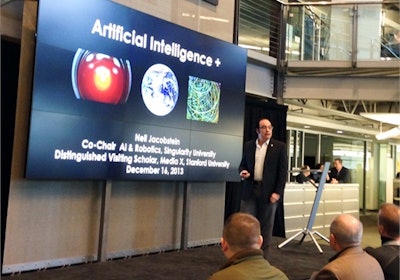
Jacobstein also discussed some interesting law enforcement twists when it comes to computer algorithms and computer intelligence. How about a computer software that analyzes and replicates the typical teenage girl’s online profile and knows how to catch a sexual predator? Well there’s a chat-bot out there that does this. It knows what dialog to use to elicit the right information from the predator to get an identification and conviction. So maybe in the not too distant future, cyber detectives will not have to make their own undercover profiles and spend hours chatting with sexual predators. There will be an app for that.
How about the concept of predictive policing? We all know about the Compstat model and maybe we’ve heard of the Smart Policing Initiative, but what about a computer program that can predict who will be a victim of a certain crime and in what geographic area it will happen? That would really be smart policing. That may be a bit far off for prime time policing, but the technology and concepts will creep into the regular crime trends meetings and before you know it, it will become reality.
Future Crimes
Marc Goodman is a strategist for Singularity University and an expert on the disruptive impact of advancing technologies on security, business,
and international affairs. With a background in local, national, and international law enforcement, he offered a fascinating perspective on what technologies police will be facing in the not too distant future. He suggested that our tendency toward openness in our online and digital profiles can be great for personal conveniences and socializing, but it’s also what the criminals are using to gather data and exploit.
We all marvel at the technologies we have at our disposal to make life easier, but there is a dark side of that technology. The dark side has terrorists setting up hi-tech ops centers and using them to help carrying out bloody attacks. A prime example is the attack on the city of Mumbai five years ago. Post incident intelligence uncovered a sophisticated operations center hundreds of miles away which fed real time data to the killers on the ground in Mumbai. The evidence shows that the terrorists used the smart data to maximize their body count. In Mumbai, we saw smartphones join the terrorists’ arsenal of guns and hand grenades. Five years is a long time ago when you think of how fast technology is advancing. It is scary to think what criminals will be using five years in the future.
Goodman talked about how a single criminal or small group of criminals can victimize hundreds of thousands of people in a single attack, thanks to accelerating technology. Years ago, the big news was Sony Playstation consoles getting hacked and thousands of users’ information being compromised. Today, the big news is the data compromise in Target Corp.'s credit card system. Again, we are looking at a single or a small group of criminals victimizing, in this case, millions of people in a single incident. Remember what I said about up-staffing our cybercrimes units? Here is a prime example of what type of crimes we are facing as law enforcement professionals.
I spoke with Goodman after his presentation and asked him what we (the police) should be doing in 2014. He suggested that we gather as much open source digital data on our targets as possible and use it to our advantage. The criminals are just as likely to be open in their online presence as their victims, and there is no reason that we shouldn’t be using that data to find the digital footprint of our targets.

How ironic, a scant 27 years after the first Robocop movie, Hollywood is making a sequel that is set to be released in February. I’m anxious to see how closely the movie parallels the realities of the accelerating technology we are facing for the actual future of police work. I’m guessing that at the end of the day, we will all be conducting our police business just like generations before us. We will, however, have some useful and very scary tools laid before us and potentially used against us. One can only hope that we have moved beyond our linear thinking when it comes to adopting new technology and set systems in place that will allow us to keep up with the criminal element.







